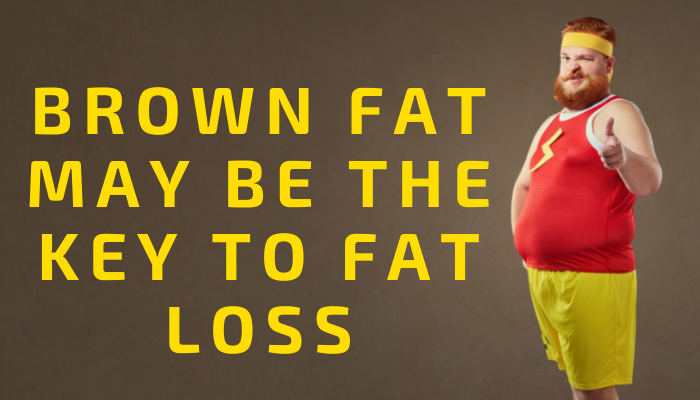
Brown Fat May Be The Key To Fat Loss
Just as scientists and therefore the public were inaccurate in regarding all dietary fat as “fat,” so, too have they been in regarding the various sorts of body fat as “fat.” When scientists, dietitians and clinicians looked past their entrenched bias, they found that some sorts of dietary fat are more readily burned versus being stored, specific fatty acids act as hormone precursors and still others offer health benefits that remain to be fully.
In the recent score of years (a score is 20, as utilized in the famous opening of Abraham Lincoln’s Gettysburg Address , “Four score and 7 years ago…”), scientists have discovered that various depots (anatomical locations) of fat have different functions; also, they need different effects on a person’s metabolism and health. The layperson (everyday people; non-scientists) generally focuses on subcutaneous fat, the fat depot that lies slightly below the skin and may be grabbed by the“Special K pinch.” Subcutaneous fat is really composed of two layers, deep and superficial.3 Superficial subcutaneous fat (the fat that’s slightly below the skin) is typical of what people and scientists long considered fat to be; a storage “warehouse” for fat to be used as energy if food availability is restricted . people that eat an excessive amount of increase the superficial layer of fat quickly, while those that are calorie deficient lose from this fat compartment. This explains the fast change in appearance with weight loss over bony areas. Lean people, or those that have recently lost a substantial amount of weight, show the ridges of bone or muscle definition in athletes thanks to a rapid loss of superficial fat.
However, superficial fat also serves a cosmetic function, because it smoothes the contours, particularly within the traditional feminine body. Plastic surgeons are careful to not intrude severely into the superficial layer because it results in ripples, trenches and noticeable defects.
If there’s a long-term imbalance in diet and activity resulting in fat gain, fat also deposits in other fat depots, including the deep subcutaneous fat layer. The deep subcutaneous fat layer isn’t just a “warehouse” that shuttles calories (as fat, or more correctly fatty acids) into and out of the bloodstream.
Deep fat appears to serve several functions. Deep and superficial fat provide a protective buffer against changes within the environment, easing the impact of minor collisions against doorframes and countertops. Deep fat is additionally vital in maintaining blood heat , acting as an insulating “blanket” against heat loss and warming/cooling blood that returns from the skin’s surface which will be significantly colder/hotter than the interior blood heat . However, deep subcutaneous fat also behaves like an organ, releasing hormone-like molecules called lipokines that affect the extent of whole-body inflammation, insulin resistance, etc. the connection between deep subcutaneous fat and insulin resistance (and other disorders) is critical in men, less so in women.4
Within the abdomen, there’s another, often ignored, fat depot called visceral fat. Visceral fat has been the recent focus of medical research, because it has been shown to be a very strong predictor of type 2 diabetes, insulin resistance, disorder , Metabolic Syndrome and other health problems.5 As previously described in deep subcutaneous fat, visceral fat releases potent lipokines that directly affect the liver, also as influencing whole-body inflammation.
These fat depots play a substantial role in regulating energy balance, weight maintenance and health. Clinicians and researchers are feverishly trying to uncover drug treatments that focus on these separate depots and positively influence health and weight status. Given the plight of America thanks to the obesity/overweight epidemic and society’s obsession with image, the terms visceral and subcutaneous fat became household words.
Yet, there’s another fat that has not been mentioned (yet) on the evening news or “pimped” on late-night infomercials.
This fat is wildly different from the opposite fat types mentioned, and permanently reason. This bizarrely mysterious fat is named “brown fat.”
The term “brown fat” differentiates this type from the more familiar “white fat” that comprises subcutaneous and visceral fat. Brown fat was long considered to be a non-issue in human physiology, because it is merely present in significant amounts in newborns.6 Brown fat holds more relevance within the animal world, because it may be a vital, life-sustaining tissue in hibernating mammals. The term mammal may be a categorical designation describing life forms that share several characteristics, including: hair , birth , milk-producing glands to feed young and maintaining a continuing blood heat . A mammal’s blood heat is primarily generated through the action of muscle, which is usually the foremost active tissue within the body. When the environment cools considerably, mammals will increase contraction , either voluntarily or by shivering.7
Muscle contraction is fairly inefficient metabolically, with approximately half (50 percent) of energy lost as heat, instead of getting used as energy (i.e., contracting the muscle; lifting a weight).8 Maintaining, or raising, blood heat may be a demanding task. this is often one among the explanations people reduce during a febrile (feverish) illness. The constant shivering necessary to boost the blood heat (fever) increases metabolic demand, and thus calorie burning, considerably.
Nature provides several samples of conditions during which a mammal may have to get heat when the muscles aren’t active. the foremost relevant is that the state of hibernation.Hibernating animals, like bats and a number of other sorts of rodents, enter a kind of “deep sleep” that lasts for months.Bears aren’t considered “true hibernators” as they maintain a near-normal blood heat and are quick to arouse, much to the chagrin of researchers who were sneaking abreast of the sleeping grizzlies. In an immobile, comatose-like state, there’s little or no muscle activity and blood heat drops; in some cases to near-freezing. However, the animals, particularly bears, who only experience a drop of 12ºF approximately , do keep blood heat above the frigid ambient conditions through the actions of a specialized tissue called “brown fat.”
Brown fat seems like fat therein it’s a tissue crammed with globules of stored fat within the fed state, but the resemblance ends there. because the name suggests, brown fat is darker thanks to a high degree of vascularity (blood vessels) and being full of mitochondria. Mitochondria are the organelles (specialized parts) of the cell that generate most of the energy (ATP) for cell function. However, brown fat is programmed to direct its mitochondria to get heat instead of produce ATP, through a process called “uncoupling.”9 Uncoupling may be a process that’s almost like holding the clutch down during a manual transmission car. When the clutch is pressed (disengaged), the transmission is “uncoupled” from the engine, and therefore the power isn’t transferred to the wheels. Hence, when the clutch is pressed, the engine turns and doesn’t create movement. If the engine runs, the energy produced is lost as heat. If the accelerator is pressed, the engine turns faster but no movement occurs as long because the clutch is disengaged; instead the speed of energy (gasoline) consumed is increased and extra heat is lost.
The mitochondria in brown fat are like engines with the clutch disengaged. Normally, the blood heat is maintained through activity and therefore the brown fat is metabolically quiet. However, during hibernation, brown fat plays a way greater role in maintaining blood heat , therefore the mitochondria become more active, very similar to an engine running at a high rpm with the clutch disengaged.
They burn more energy (not gas but calories), which is lost as heat. This heat is transferred to the remainder of the body through the bloodstream (remember, brown fat is very vascular).
This review in mammalian physiology would appear to be of little value in humans, as there’s little or no brown fat in adults, the first audience affected by dysfunctional weight management. this is often to not say that there’s not any, it’s just very limited. In adults, what brown fat exists lies in fairly small and specific areas, including: cervical, supraclavicular, paravertebral, mediastinal, para-aortic and suprarenal regions. These regions lie along the trail of major blood vessels, which is logical because the adult-remnant of brown fat likely exists to take care of core blood heat within the event of prolonged immobility or cold environmental exposure. As healthy adults are capable of generating a substantial amount of muscular activity, there’s no use for an energy-demanding tissue whose primary (maybe only?) purpose is to get heat; particularly within the age of climate-controlled housing.
Surprising Origins Of Brown Fat
Recently, the origin and lineage of brown fat decided , delivering surprising revelations to the scientific community. When first described in 1551 by Swiss naturalist Konrad Gessner, brown fat was mentioned as being “neither fat nor flesh,” meaning it didn’t appear to be fat or muscle.10 Under the microscope, brown fat contains globules of fat, but is additionally densely full of mitochondria. It doesn’t contract and doesn’t appear to secrete any identifiable hormone(s). it had been reasonable to pigeon-hole brown fat as a kind of adipose (fat cell), because it didn’t appear to possess a function in humans.
However, with the advances in gene mapping, cell biology and markers of differentiation (cells maturing from stem cells to completely functional cells), it became possible to trace brown fat back to its early precursors. the invention was shocking. Dr. Patrick Seale of Harvard school of medicine and a team of colleagues reported within the journal Nature that brown fat springs from a precursor cell within the striated muscle line.11 In other words, brown fat may be a close relative to muscle, and only distantly associated with white fat.
The specifics of this study truly are amazing. Unfortunately, to completely appreciate the methods used and therefore the results that cause this newsworthy conclusion requires a familiarity with cell differentiation markers. However, a quick description, relying upon the recognition of the tv series “CSI,” should offer some idea of why researchers are excited.
Every human begins from one cell, a sperm-fertilized ovum (egg cell) that mixes traits from the biologic father and mother. because the fetus grows, the cells begin to “specialize” into specific tissue so as to make the “parts” that make a person’s . Cells become different so as to become blood cells, liver tissue, brain matter, muscle, heart, kidneys, etc.
Even in adults, a “pool” of early, undifferentiated cells remains to exchange cells lost to age or injury.
These early cells are the cave men within the evolution of cells.
The earliest forms are called stem cells, and represent embryo-like cells which will become variety of various sorts of cells. because the stem cells evolve, they become more developed and plan to becoming one specific sort of cell.
At an early point, white fat cells and striated muscle share a standard precursor cell. within the presence of androgens and other factors, these common precursor cells plan to becoming either white fat or muscle.12 consider this common precursor as a cellular “missing link.” In muscle, this “missing link” cellular cave man evolves (differentiates) into a Neanderthal-like myoblast (early muscle fiber ) that then evolves into the mature muscle cell (modern man).
What Seale and his colleagues discovered was that brown fat expressed proteins that were found only within the muscle fiber line, not the white fat line.11 it had been the cellular like realizing that gorillas were exposure to Thanksgiving dinner because they were not distant cousins to mankind, but first cousins to us all. Tracing brown fat backward, Seale showed the purpose where brown fat and muscle diverge. Certain signals that determine whether this common brown fat-skeletal muscle precursor commits to brown fat or muscle were also define.11,13
Aside from the tutorial interest these findings inspired, the therapeutic promise of accelerating brown fat levels in humans has not gone unnoticed. Remember, adult humans have little brown fat, as heat-generating needs are met by striated muscle , the “first cousin” to brown fat. All an individual must do to get heat (and waste calories) is move around, exercise or maybe shiver.
Unfortunately, having the ability to move doesn’t mean people necessarily are, particularly if their occupation isn’t labor-based. within the pursuit of effortless solutions to the American obesity crisis, researchers are watching brown fat as a possible target for weight management.
On the face of things, this seems reasonable. After all, if a sign might be generated by a pill that might induce a ten percent to twenty percent increase in daily energy expenditure, it might be the metabolic equivalent of “exercise during a pill.” Yet, there are problems with this approach. First, there’s little brown fat in adults, the first population affected by overweight and obesity-related consequences. So directly stimulating brown fat because it exists is fairly futile thanks to the limited effect.6 The “promise” of brown fat lies in increasing the entire amount of brown fat to a big amount of the entire body mass then stimulating it to extend daily energy expenditure (the number of calories burned during the day). However, there are three serious drawbacks to the present proposal that haven’t been fully considered.
The Skinny On Brown Fat
Brown fat arises from an equivalent precursors as striated muscle . so as to extend brown fat, the signals for cellular differentiation need to be switched from pro-muscle to pro-brown fat. By favoring the commitment to brown fat, the precursor pool for striated muscle is depleted and therefore the body is impaired relative to responding to exercise or muscle injury.
In a society where frailty and inactivity have contributed to the obesity problem, this is often a drawback that must be strongly considered. There are potential ways of doing this, prompting the precursor cells to become brown fat, including an identified transcriptional regulator called PRDM16, also as PPAR-gamma activators, vegetable oil and garlic.14-16
The “waste” product for brown fat when it’s burning calories is heat. The body can only tolerate a limited range of blood heat before catabolism, fatigue and tissue damage occurs. In extreme cases, the brain can “cook” and an individual can die from hyperthermia (excessively high body temperature). People, particularly infants, can suffer from high fevers reaching over 105ºF. If this temperature persists, brain damage and death can occur in hours to days. Even a persistent lesser fever can cause problems with cognition (thinking) and organ function, including dehydration from pronounced sweating. Certain people are particularly sensitive to certain anaesthetics and enter into a state referred to as autosomal dominant disease when being anesthetize for surgery.17 this is often a medical emergency and is treated very aggressively when it happens. The uncoupling drug DNP (2,4 dinitrophenol), employed by many weight trainers to scale back body fat, has been implicated in a minimum of two deaths.18
Even if brown fat might be “metered” to supply only a group amount of warmth , it’s stimulated by beta-adrenergic stimulants— drugs like adrenalin. This class of drug was used for many years , as skeletal muscles answer an equivalent drugs by increasing heat production and cellular activity, the so-called “thermogenic” weight loss drugs and supplements. Unless beta-adrenergic drugs specific to brown fat are developed, the potential for adverse cardiovascular effects or mood disturbances are even as relevant as they were with ephedrine-products and clenbuterol.19
It is amazing that brown fat acts very similar to muscle, despite being a cell that stores fat (temporarily). It is sensible in terms of evolution/development and survival that a heat-producing tissue would be needed during times of prolonged immobility or hibernation. When one cares the shared functions of striated muscle and brown fat with regard to maintaining a gentle temperature, the revelation that they’re closely related tissues becomes logically apparent. for hundreds of years , brown fat was considered a fat, proving once more appearances are often deceiving.
One possible use for brown fat generation/stimulation therapy might be in treating comatose patients or those that have suffered a stroke with resulting paralysis. Yet, for the athlete, even the healthy non-athlete, manipulating brown fat and therefore the shared brown fat/muscle precursors to spice up calorie burning and reduce body fat may have unintended negative consequences. For now, chalk this discovery to the (very) interesting, but likely of little practical value for active adults category. In fact, an equivalent benefit could likely be achieved by reclining during a cool bath until the water gets cold enough to induce shivering.20 I used the technique to drop body fat in preparation for competition but the practice holds risk for those with heart conditions, so it shouldn’t be attempted on faith with one’s personal physician.
References: 1. Leaf A. Historical overview of n-3 fatty acids and coronary heart disease. Am J Clin Nutr, 2008 Jun;87(6):1978S-80S. 2. Kien CL, Bunn JY, et al. Increasing dietary palmitic acid decreases fat oxidation and daily energy expenditure. Am J Clin Nutr, 2005 Aug;82(2):320-6. 3. Walker GE, Verti B, et al. Deep subcutaneous adipose tissue: a distinct abdominal adipose depot. Obesity, (Silver Spring) 2007 Aug;15(8):1933-43. 4. Miyazaki Y, Glass L, et al. Abdominal fat distribution and peripheral and hepatic insulin resistance in type 2 diabetes mellitus. Am J Physiol Endocrinol Metab, 2002 Dec;283(6):E1135-43. 5. Fox CS, Massaro JM, et al. Circulation, 2007 Jul 3;116(1):39-48. 6. Asakura H. Fetal and neonatal thermoregulation. J Nippon Med Sch, 2004 Dec;71(6):360-70. 7. Rintamaki H. Human responses to cold. Alaska Med, 2007;49(2 Suppl):29-31. 8. Henchoz Y, Malatesta D, et al. Effects of the transition time between muscle-tendon stretch and shortening on mechanical efficiency. Eur J Appl Physiol, 2006 Apr;96(6):665-71. 9. Watanabe M, Yamamoto T, et al. Cold-induced changes in gene expression in brown adipose tissue: implications for the activation of thermogenesis. Biol Pharm Bull, 2008 May;31(5):775-84. 10. Cannon B, Nedergaard J. Neither fat nor flesh. Nature, 2008 Aug 21;454:947-8. 11. Seale P, Bjork B, et al. PRDM16 controls a brown fat/skeletal muscle switch. Nature, 2008 Aug 21;454(7207):961-7. 12. Singh R, Artaza JN, et al. Androgens stimulate myogenic differentiation and inhibit adipogenesis in C3H 10T1/2 pluripotent cells through an androgen receptor-mediated pathway. Endocrinology, 2003 Nov;144(11):5081-8. 13. Seale P, Kajimura S, et al. Transcriptional control of brown fat determination by PRDM16. Cell Metab, 2007 Jul;6(1):38-54. 14. Centers for Disease Control and Prevention. Heat-related deaths–United States, 1999-2003. MMWR Morb Mortal Wkly Rep 2006 Jul 28;55(29):796-8. 15. Oi-Kano Y, Kawada T, et al. Extra virgin olive oil increases uncoupling protein 1 content in brown adipose tissue and enhances noradrenaline and adrenaline secretion in rats. J Nutr Biochem, 2007 Oct;18(10):685-92. 16. Oi Y, Kawada T, et al. Allyl-containing sulfides in garlic increase uncoupling protein content in brown adipose tissue and noradrenaline and adrenaline secretion in rats. J Nutr, 1999 Feb;129(2):336-42. 17. Rosenberg H, Davis M, et al. Malignant hyperthermia. Orphanet J Rare Dis, 2007 Apr 24;2:21. 18. Miranda EJ, McIntyre IM, et al. Two deaths attributed to the use of 2,4-dinitrophenol. J Anal Toxicol, 2006 Apr;30(3):219-22. 19. Chan TY. Food-borne clenbuterol may have potential for cardiovascular effects with chronic exposure (commentary). J Toxicol Clin Toxicol, 2001;39(4):345-8. 20. Pretorius T, Cahill F, et al. Shivering heat production and core cooling during head-in and head-out immersion in 17 degrees C water. Aviat Space Environ Med, 2008 May;79(5):495-9.

HOW TO GET RIPPED AND FIT IN A MONTH, IS IT POSSIBLE?
También te puede interesar

BICEPS OF STEEL: TRANSFORM YOUR ARMS WITH THESE 3 POWERHOUSE EXERCISES
abril 10, 2023
BALANCE IN DIET AND SUPPLEMENTS FOR BODYBUILDING AND FITNESS
diciembre 12, 2023


